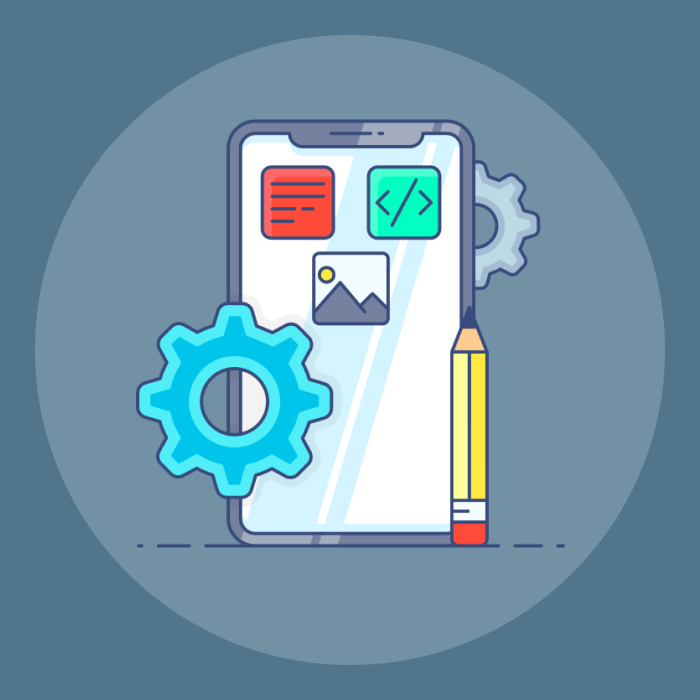In today's app-centric world, success isn't just about coding and features but creating user-centric designs. Learn why it's crucial and how to do it in this comprehensive guide.
Today, where apps dominate our daily lives, creating a successful mobile application isn't just about coding and functionality but also the app's design. It's about making an impact on users, creating an experience that keeps them coming back for more.
Imagine you've spent months creating what you believe is the perfect mobile app for the users. It has all the features, is sleek, and works like a charm. But when you launch it, it doesn't quite get the response you were hoping for. Users can barely navigate/use the app, and your app's ratings are plummeting.
This is a situation no marketer or designer wants to find themselves in. One simple mantra, 'user-centric design,' can avoid this situation. But what exactly is it?
That's why creating an app focused on user-centric design is necessary. This comprehensive guide will explore what it is, why it's crucial, how to implement it, the steps involved, future trends, and why marketers need to embrace it.
1. What is user-centric design?
User-centric design is an approach to product design that focuses on the end-users' needs, preferences, and behaviors. This is also known as user-centered design (UCD). It's about creating an app that doesn't just function well but gives a great user experience.
Think of it as a way to build an app that feels tailor-made for each user. It's about making your app users the centerpiece of your app design process, understanding user's pain points, and delivering solutions that make their lives easier.
User-centric design involves understanding users' behaviors, expectations, and pain points through user research and persona development. It emphasizes the importance of empathy, putting designers and developers in the users' shoes to create solutions that truly cater to their needs.
User-centric design's purpose is to provide satisfaction, increase engagement, reduce user churn, increase loyalty, and positively impact marketing efforts by aligning the application with the desires of its users.
2. Importance of user-centric design
User-centric design is crucial because 90% of people won't use an app if they don't find it visually appealing. This means that creating apps that are easy on the eyes and user-friendly is essential for attracting and retaining users, ultimately leading to the app's success.
However, let's dive into some more fundamental reasons:
Enhancing user satisfaction
Happy users are loyal users. They're your best marketing tool. They write glowing reviews, tell their friends, and stick around for the long haul. Happy users are the Holy Grail of app success.
When users stumble upon an app that understands their every move and need, it's like finding a hidden gem. They feel pampered, unique, and totally in sync with your app. That's the kind of bond that transforms a casual user into a devoted fan.
Increasing user engagement
Increased user engagement isn't just a feel-good metric; it's the lifeblood of your app. Engaged users spend more time, click more links, and interact more. And guess what? That translates to revenue opportunities. Happy users equal a comfortable bank account.
Think of your app as a party. A user-centric app is like a host who knows how to keep the party alive. It's intuitive and friendly and encourages users to stay and mingle. They're not just popping in; they're here for the long haul.
Reducing user churn
User churn is like a leak in your boat. Users abandon ship when things get rocky. And guess what rocks their boat? Frustration. An app that doesn't "get" them that's confusing or glitchy sends them packing.
But here's the twist - user-centric design can plug those leaks. By understanding user pain points, you can sail through smoother waters. Users who feel heard and valued are less likely to jump ship.
Boosting app retention and loyalty
Building an app isn't a one-night stand; it's a relationship. A user-centric app is your Romeo serenading Juliet. It's your way of saying, "I'm here for the long haul, baby!"
Loyal users are a goldmine. They don't just use your app; they recommend it to others. They tell their tribe, spread good words about your app, and defend it in the face of haters. Loyalty equals steady growth and revenue.
Impact on marketing and branding
Your app's design isn't just pixels on a screen; it's an extension of your brand's soul. A user-centric app sends a powerful message - "We care about you." It's like a warm, welcoming hug from your brand.
Users who experience a seamless, enjoyable app associate those good vibes with your brand. It's a brand-building win! Positive user experiences fuel your reputation, drive word-of-mouth buzz, and attract new users like moths to a flame.
3. Examples of user-centric design
User-centric design focuses on creating products and services with users' needs and preferences at the forefront. Here are key examples of user-centric apps in action:
1. Yelp
We designed this app to help users find local business reviews and make reservations effortlessly. Yelp has improved its design by incorporating user-friendly features into the navigation section of its website.
While exploring the Yelp app, users can efficiently browse a list of restaurants using the integrated map feature. This makes it easy to pinpoint a business's exact location.
2. Instacart
Using the Instacart app, users will notice they've designed their interface thoughtfully with text that's easy to read, especially for folks who might be visually impaired. And, oh yeah, they've tossed in some User-Centered Design magic in the cart section.
Users can toss items into their cart directly from the main page. It's much faster than other services where they have to check out your cart just to mess with the quantity of something you've already picked. Instacart keeps it snappy!
3. Duolingo
This language-learning app that's all about keeping it simple. It has a super primary interface that makes learning a language a total breeze as you do your tasks.
Duolingo kicks it up by turning the whole language-learning thing into a game. You complete a section, and boom! You unlock new categories. It's like leveling up in a video game, but you're leveling up your language skills. So, you stay engaged and hit that goal of mastering a new language. Cool, right?
4. How to create a user-centric design?
Crafting a user-centric design is not just about following a checklist of best practices. It's a voyage that requires a fundamental shift in mindset—a journey where every stage of app development resonates with the heartbeat of your users.
1. Shifting the Perspective
Shifting your perspective towards a user-centric approach isn't merely a checkbox; it's about embracing empathy. It's about stepping into your users' shoes and seeing the world from their eyes.
Tip: Do User Interviews and Surveys
Start with user interviews and surveys. Engage in one-on-one conversations with users and dive deep into their thoughts, emotions, and experiences.
Open-ended questions are your best friends here; they encourage users to pour their hearts out. The insights you glean will serve as the North Star guiding your design decisions.
2. Team Collaboration
The symphony of user-centric design is a collaborative masterpiece. It's not the sole responsibility of the design team but a harmonious effort that involves developers, marketers, and every stakeholder in the mix.
Tip: Interdisciplinary Collaboration
In the world of user-centric design, interdisciplinary collaboration is the secret sauce. Bring developers into the design conversation early. Their technical expertise ensures that your visionary designs are practically executable.
Marketers, on the other hand, are the custodians of user behavior and preferences. Their insights paint the landscape for your design strokes. When these teams unite in harmony, you craft an app that doesn't just look good but dances to the tune of seamless functionality while aligning with your brand's marketing serenades.
3. Alignment with Business Goals
Your app's success relies on blending user-centric design with business goals. For instance, in the development of a fintech app, where fintech app development cost is a concern, the priority is offering personalized financial services.
For example, if you're designing a fintech app, your business goal might be to provide more personalized financial services.
Your user-centric design strategy should then revolve around features and experiences that promote engagement, such as personalized financial recommendations for any kind of loan, EMIs, etc.
Tip:
The secret sauce here is alignment. Define your business objectives with laser precision—boosting revenue, expanding your user base, or nurturing customer loyalty. Then, envision how user-centric design can be where these goals shine.
For instance, if you aim to boost revenue, a user-friendly checkout process could be your virtuoso performance, reducing cart abandonment rates. This alignment ensures that your design isn't just user-centric but a strategic force propelling your brand's grand narrative.
Now, let's dive into the practical steps of designing a user-centric app.
5. Steps of creating user-centric app design
Creating an app that genuinely speaks to users isn't just about checking off boxes; it's a journey that demands a profound commitment to user-centricity. Here are the intricate steps that lead to user-centric app design, plumbing the depths to understand what it truly entails.
1. Defining User Personas
User personas aren't just profiles with demographic details; they're living, breathing entities representing your ideal users. They delve beyond the surface into behaviors, aspirations, pain points, and motivations.
- Research and Data Collection: You embark on a research voyage to create these personas in their full glory. You delve into surveys, user analytics, and even the strategies of your competitors. This data is your treasure chest, revealing the secrets of user behavior and preferences.
- Persona Creation: Once armed with data, you give life to these personas. You don't just name them; you give them personalities. "Adventure-Seeker Alex" becomes a natural person with age, profession, and a vivid backstory. It's like crafting characters for a novel, only this time, it's for your app's story.
2. User Journey Mapping
User journey mapping isn't a mere visualization; it's an emotional voyage through your app's landscape. It's about understanding every heartbeat of the user experience from start to finish. Go in-depth with these steps:
- Identifying Key Touchpoints: You map every interaction, from that first discovery in an app store to the triumphant moment when a user achieves their goal. It's like plotting the course of a thrilling adventure.
- Analyzing User Flow: But you don't stop at mapping; dive into the emotional waters. What are users thinking, feeling, and doing at each stage? Where do they find joy, and where do they stumble? This is where you uncover the hidden gems and potential pitfalls in the user's journey.
Wireframing isn't just about sketching; it's blueprinting the architecture of your app, laying the foundation for an exceptional user experience. Here's how to do it thoroughly:
- Sketching and Basic Layouts: You start with raw sketches, like an architect's rough blueprint. Every line, every element, every pixel matters. You consider every aspect's layout, hierarchy, and placement. User personas and their journeys guide every stroke of the digital pen.
- Organizing Content and Navigation: Beyond visuals, you delve into the structure of information. How do users navigate through this labyrinth of digital experience? It's about ensuring that your app's architecture makes sense and offers a seamless path for users to find what they seek.
4. Prototyping and Interactive Design
Prototyping isn't just about making a model; it's about bringing dreams to life. It's where your static wireframes come alive with interactivity. Here's how to create an engaging and user-centric prototype:
- Creating Interactive Mockups: You wield prototyping tools to turn those lifeless sketches into living prototypes. Users can now click, swipe, and interact. It's like riding a manuscript into a movie. Users don't just read; they experience.
- User Interaction Testing: But you don't stop there. You invite real users to the theater. You observe how they interact with your creation. Where do they stumble? Where do they dance? It's a live performance, and their reactions are your cues for improvement.
5. Usability Testing and Feedback Incorporation
Usability testing isn't a one-time event; it's a continuous symphony that ensures your app stays in tune with users. Here's how to make the most of it:
- Conducting Usability Tests: Users are your audience, and you put on regular shows. They perform typical tasks, and you watch with bated breath. How do they navigate the labyrinth? Are they delighted, or do they falter?
- Adapting Design Based on User Feedback: The show's not over when the curtain falls. You take a bow, collect feedback, and return to the drawing board. If users struggle with a particular scene, you rewrite it. It's an ongoing performance, an eternal cycle of improvement.
Now that we've covered the practical steps let's explore the future of designing user-centric apps in-depth.
6. Future trends for designing user-centric apps
In the ever-evolving app development world, staying ahead means anticipating the future. Let's explore the exciting trends shaping user-centric app design in the coming years.
1. Artificial Intelligence and Machine Learning Integration
Artificial Intelligence (AI) and Machine Learning (ML) are not just buzzwords; they're the secret sauce behind hyper-personalized user experiences.
- Personalized Content: Picture this – AI algorithms analyze user preferences to serve content tailored to individual tastes. Whether it's news articles, product recommendations, or entertainment, the future belongs to content that understands you like a trusted friend.
- Predictive User Assistance: Think of apps that anticipate your needs, like an AI-driven virtual assistant suggesting healthy recipes when it detects your newfound interest in fitness. It's like having a personal assistant with a sixth sense.
- Chatbots and Virtual Assistants: AI-powered chatbots are no longer text-based helpers; they're evolving into conversational companions. They provide instant customer support, answer questions, and seamlessly guide users through complex tasks.
2. Augmented Reality and Virtual Reality Experiences
Augmented Reality (AR) and Virtual Reality (VR) are about to flip the script on user engagement by offering immersive experiences.
- Virtual Shopping: Imagine trying on clothes or visualizing furniture in your home before purchasing online. AR and VR are turning shopping into a virtual runway and showroom.
- Educational VR: Schools and training programs adopt VR to create immersive learning environments. Education has evolved from textbooks; it's now an interactive journey.
- Virtual Tourism: Wanderlust meets technology. Travelers can explore destinations virtually, tasting their future adventures before packing their bags.
3. Voice and Conversational User Interfaces
Voice-activated and conversational interfaces are stepping into the limelight, especially with the surge of smart speakers and virtual assistants.
- Voice Search Optimization: Apps integrate voice search, making finding information or products effortlessly using voice commands. It's like having a digital genie at your beck and call.
- Conversational Commerce: Making purchases and interacting with businesses through messaging apps or voice assistants stream the customer journey. It's shopping and support, all in a casual conversation.
- Voice-Driven Health and Wellness: Even healthcare is jumping on the voice bandwagon. Apps are incorporating voice commands for tasks like medication reminders and health tracking. Your health just got a voice.
4. Personalization at Scale
The future of user-centric design is about delivering highly personalized experiences, not just for a handful of users - for everyone.
- Hyper-Personalization: Apps will dive deep into the ocean of data, offering hyper-personalized content, products, and services. It's like a butler who knows you better than you know yourself.
- Predictive Personalization: AI algorithms will be your crystal ball. They'll predict your needs and preferences before you realize them, creating seamless, anticipatory experiences. It's like the app can read your mind.
Users don't stick to one platform or device, and neither should your app. The future demands consistency, no matter where or how users engage.
- Responsive Design: Apps will be like chameleons, seamlessly adapting to different screen sizes and orientations. The look and feel will remain consistent whether it's a smartphone, tablet, or desktop.
- Cross-Device Sync: You can start a task on one device and effortlessly continue it on another without a hitch. It's like having a digital assistant who follows you from room to room.
Conclusion
Building a user-centric app can be your key to success in a world where apps are a dime a dozen. It's not just about making an app; it's about making a difference in your users' lives. As a marketer, implementing user-centric design is good practice and a strategic move that can drastically impact your brand's and app's reputation.
Subscribe to weekly updates
You’ll also receive some of our best posts today






